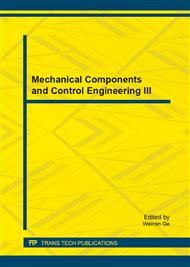p.611
p.615
p.619
p.625
p.629
p.633
p.637
p.641
p.647
Research and Design of Permanent Magnet Synchronous Motor Vector Control for Electric Vehicle
Abstract:
As the electric vehicles usually run under complex conditions of city road, there always exists parameter perturbation of motor, which will affect the vehicle performance. To solve the problem, an improved sliding mode variable structure control (SMC) method which combines continuous function and reaching law has been proposed in this paper. Then the improved vector control algorithm’s codes are generated automatically in the MMC (Model-based Motor Control) platform. The results show that the improved SMC algorithm has small chattering and strong robustness to the parameter perturbation and the external disturbances.
Info:
Periodical:
Pages:
629-632
Citation:
Online since:
October 2014
Authors:
Keywords:
Price:
Сopyright:
© 2014 Trans Tech Publications Ltd. All Rights Reserved
Share:
Citation:


